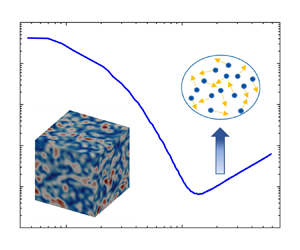Published online by Cambridge University Press: 21 May 2024

This study investigates the impact of molecular thermal fluctuations on compressible decaying isotropic turbulence using the unified stochastic particle (USP) method, encompassing both two-dimensional (2-D) and three-dimensional (3-D) scenarios. The findings reveal that the turbulent spectra of velocity and thermodynamic variables follow the wavenumber (k) scaling law of  ${k}^{(d-1)}$ for different spatial dimensions
${k}^{(d-1)}$ for different spatial dimensions  $d$ within the high wavenumber range, indicating the impact of thermal fluctuations on small-scale turbulent statistics. With the application of Helmholtz decomposition, it is found that the thermal fluctuation spectra of solenoidal and compressible velocity components (
$d$ within the high wavenumber range, indicating the impact of thermal fluctuations on small-scale turbulent statistics. With the application of Helmholtz decomposition, it is found that the thermal fluctuation spectra of solenoidal and compressible velocity components ( ${\boldsymbol {u}}_{s}$ and
${\boldsymbol {u}}_{s}$ and  ${\boldsymbol {u}}_{c}$) follow an energy ratio of 1 : 1 for 2-D cases, while the ratio changes to 2 : 1 for 3-D cases. Comparisons between 3-D turbulent spectra obtained through USP simulations and direct numerical simulations of the Navier–Stokes equations demonstrate that thermal fluctuations dominate the spectra at length scales comparable to the Kolmogorov length scale. Additionally, the effect of thermal fluctuations on the spectrum of
${\boldsymbol {u}}_{c}$) follow an energy ratio of 1 : 1 for 2-D cases, while the ratio changes to 2 : 1 for 3-D cases. Comparisons between 3-D turbulent spectra obtained through USP simulations and direct numerical simulations of the Navier–Stokes equations demonstrate that thermal fluctuations dominate the spectra at length scales comparable to the Kolmogorov length scale. Additionally, the effect of thermal fluctuations on the spectrum of  ${\boldsymbol {u}}_{c}$ is significantly influenced by variations in the turbulent Mach number. We further study the impact of thermal fluctuations on the predictability of turbulence. With initial differences caused by thermal fluctuations, different flow realizations display significant disparities in velocity and thermodynamic fields at larger scales after a certain period of time, which can be characterized by ‘inverse error cascades’. Moreover, the results suggest a strong correlation between the predictabilities of thermodynamic fields and the predictability of
${\boldsymbol {u}}_{c}$ is significantly influenced by variations in the turbulent Mach number. We further study the impact of thermal fluctuations on the predictability of turbulence. With initial differences caused by thermal fluctuations, different flow realizations display significant disparities in velocity and thermodynamic fields at larger scales after a certain period of time, which can be characterized by ‘inverse error cascades’. Moreover, the results suggest a strong correlation between the predictabilities of thermodynamic fields and the predictability of  ${\boldsymbol {u}}_{c}$.
${\boldsymbol {u}}_{c}$.